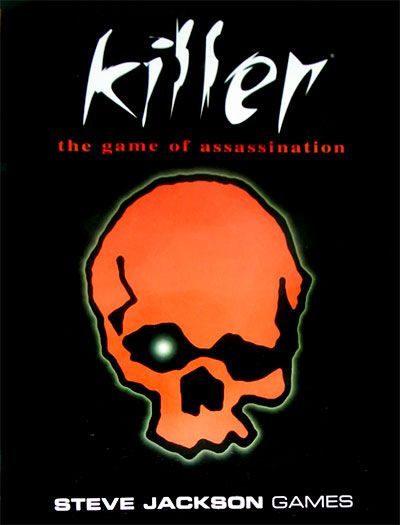Welcome to my review of Killer! If you’ve ever wanted to see your friends turn into paranoid detectives (or sneaky murderers) without breaking any actual laws, you’re in the right spot. I’ve played this wild party game more times than I’ve lost at Monopoly, which is a lot. Spoiler: Killer’s rules are simple, the tension is real, and someone will definitely accuse the quietest person in the room. Ready to find out if it’s worth adding to your game night? Grab a seat—just make sure no one’s eyeing you funny.
How It Plays
Setting up
Grab a deck of cards. Deal one card facedown to every player. Make sure one card is a spade—that’s the secret killer. Everyone else gets a heart, club, or diamond, making them regular party guests. Nobody shows their card! Sit in a circle, pretend you’re at a fancy murder mystery party, and try not to look guilty already.
Gameplay
The game is all about sneaky eye contact. The killer tries to “kill” people by winking at them, while everyone else tries to spot the killer before they get taken out. If you get winked at, act dramatically and “die.” But keep your mouth shut on the killer’s identity! Anyone can accuse someone of being the killer but if they’re wrong, they’re out. Drama, suspense, and a lot of bad acting will follow.
Winning the Game
If the killer successfully winks out everyone else or no one guesses their identity, the killer wins. If someone catches the killer with a correct accusation, the rest of the party lives happily ever after—and you get bragging rights. Simple to learn, but don’t underestimate the drama!
Want to know more? Read our extensive strategy guide for Killer.
How to Play Killer: Catch On in Minutes, Survive for Hours
The first time my group tried Killer, I prepared my official Board Game Rules Voice™. You know, the overly-serious tone you use when nobody can work out the setup? Turns out, Killer didn’t need it. The whole game fits inside a mental post-it note. Here’s how it works: grab a pack of standard playing cards and the highest number of players you can find (the more, the messier). Everyone gets a card, face down. If you get the joker, congratulations, you’re the killer. If not—well, don’t get killed.
The rules are as clear as my dad’s head after a trip to the barber: killers wink at people to “eliminate” them, while everyone else tries to spot the killer before it’s too late. If you get winked at, you perform your best dramatic death (mine always involves clutching my chest and moaning, which nobody appreciates). When you think you know the killer, you can accuse—but blow it, and you’re out faster than a wet dog at a wedding.
It took us literally two minutes to teach Killer to some friends who don’t usually play board games. My cousin even learned the game while eating a sandwich and scrolling her phone, so yes, it’s that simple. There are zero fiddly tokens or brain-melting rulebooks. The trickiest part is not giggling every time the killer makes their move.
If you’re nervous about bringing a new game to a party, Killer wins for approachability. Next up: does Killer reward clever players or just people with beginner’s luck? Let’s find out if my cousin’s five-game win streak was skill or sorcery.
Does Killer Reward Skill or Just Lucky Guessing?
Let me be real with you—I have strong feelings about games that let luck steal the show. I want my brain to work for that win, not just my lucky socks. Killer sits in a weird spot on the luck-to-skill spectrum. It’s not just random, but don’t expect to win just because you can outsmart a Mensa club, either.
In my first game with friends, I figured I’d channel my inner Sherlock. I tried to catch every tiny quirk and twitch. Nothing. Jorge, who once lost at tic-tac-toe to his cat, took the win just by guessing who the killer was in round two. We all stared at him like he’d just solved world hunger. Nope, just a lucky guess. That said, over a few games, you start to get a feel for patterns. If you can read people well, spot the guilty, and keep a straight face while being the killer, you’ll rack up more wins. But don’t get too cocky—one wild accusation or nervous laugh and it’s game over.
So for Killer, I’d say it’s about 60% skill, 40% luck, plus a big chunk of reading your friends. Bluffing and social skills matter loads, but the wrong guess at the wrong time will send you packing. If you hate games where the dice make all the choices, you’ll have more fun here than Monopoly, but don’t expect chess-level control.
Will you thrive under suspicion or crumble like a week-old cookie? Let’s talk about how Killer turns friends into shifty suspects in the next section on player interaction and tension!
Why Killer Keeps You Glued to Your Seat: Player Interaction and Tension
Let me tell you, playing Killer with friends is a wild ride. This is not a game where you can hide in a corner eating snacks. No, sir. Killer forces everyone into the spotlight, even that one friend who just wants to text under the table. Every round, you have to look your friends in the eye and try not to laugh, sweat, or give away that you might be the Killer. The accusing starts off slow, but by round three, even your grandma is pointing fingers and throwing shade.
The tension is thick enough to cut with a butter knife (don’t actually bring a knife to game night though, please). You never know who will turn on you, and one tiny mistake—like laughing when someone says “it’s definitely not me”—can send the whole group after you. Shouting, laughter, fake tears, and some Oscar-worthy acting mix together for an experience that is as much about reading people as it is about following the rules. With so much bluffing and suspicion, nobody is safe. I once got accused by my dog (well, he barked at me, so same thing).
If you like games where you get to be part detective, part drama queen, and a bit of a chaos gremlin, Killer absolutely delivers. Every night ends with someone yelling “I KNEW IT WAS YOU!” across the living room. Next up, let’s see if the replay value holds up when you shake up the group—because variety is the spice, or at least the salsa, of game night!
Replay Value: Killer With Fresh Faces (And Old Friends)
Some games fizzle after a few rounds. Not Killer! I’ve played this with my drama-loving cousin, my book club, and even my grandma (who is way too good at lying, just saying). Every group brings a different energy to the table. With my cousin, Killer turns into a full-on improv show with Oscar-worthy death scenes. With my book club, it’s all about analyzing each other’s poker faces. Grandma? She’s just terrifying and always wins. I suspect she’s secretly an international spy.
Killer’s rules are so simple that everyone gets involved right away. The fun part is watching how different circles twist the game to their own personalities. Some people get sneaky, slipping invisible notes and whispering their killer plans. Others prefer wild accusations and dramatic monologues. If you play with a quieter group, the tension simmers under the surface like a kettle about to screech. In rowdy crowds, it’s chaos. Both are a blast.
What stands out is how Killer never repeats itself. The same group never plays it the same way twice, and a new group turns it into something else entirely. That gives it huge replay value. Even after a dozen rounds, you’ll catch yourself thinking, “Just one more!”
So do I recommend Killer? Absolutely, if you like games where the real star is the people at the table. Just don’t trust grandma. Seriously.
Conclusion
Killer is a party game that wins over almost any crowd, as long as you don’t mind a bit of suspicion and a lot of laughter. The rules are easy, so anyone can join in—even the friend who shows up late and hasn’t read anything. While luck can play a part, skillful bluffing and keeping a poker face really pays off. I love how each game feels different depending on the group—and no round is ever the same. If you want a fast, fun game for groups big or small, Killer won’t let you down. Just keep an eye on your most innocent-looking friends! This concludes my review—now, go catch that killer!


